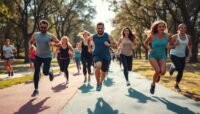Welcome to your ultimate guide on Fitness and Exercise, where we start a journey to better health. This guide will show you why adding fitness to your day is key. It points out how staying active can greatly lower the chance of chronic diseases, with support from the American Heart Association and the CDC. Let’s dive into the advantages, plans, and useful advice for integrating fitness into your life.
Key Takeaways
- Understanding the importance of fitness can transform your health.
- Physical activity is essential in reducing chronic disease risk.
- Setting goals is crucial for a successful wellness journey.
- Different workout routines target various fitness needs.
- Nutrition plays a vital role in achieving your fitness objectives.
The Importance of Fitness and Exercise
Regular fitness and exercise are key to good health. They better not just your body but also your mind. Physical activity goes beyond burning calories. It greatly improves both physical health and mental health for those who make it a priority.
Benefits for Physical Health
Physical activity brings many health benefits, enhancing life’s quality. These benefits include:
- Improved cardiovascular health: Regular exercise makes the heart stronger and improves blood flow.
- Weight management: Being active helps control your weight by burning calories.
- Enhanced muscle strength: Working against resistance increases muscle power, improving performance.
Mental Health Advantages
The link between exercise and mental wellbeing is strong. Regular workouts can boost mental health in many ways:
- Reduced anxiety and depression: Exercise releases endorphins, boosting mood and lessening anxiety.
- Better stress management: Working out is a great way to relieve stress.
- Improved cognitive function: Staying fit can sharpen memory and brain function.
Choosing the Right Workout Routine
Finding the right workout routine is key to reaching your fitness goals. It starts with knowing what you want to achieve. Selecting the right activities for your goals means looking at your fitness level and what you like. This makes sticking to fitness more fun and doable.
Identifying Your Fitness Goals
First, you need to know your fitness goals. It could be losing weight, building muscle, or boosting health. Set specific goals to find the best workouts for you. Think about these important points:
- Motivation: Determine what inspires you to stay active.
- Time Commitment: Assess how much time you can realistically dedicate to training.
- Physical Limitations: Be mindful of any injuries or conditions that may affect your choice of workouts.
Types of Workout Routines
There are many workout routines that fit different goals and likes. Here are some popular ones:
| Workout Type | Description | Best For |
|---|---|---|
| Strength Training | Focuses on building muscle through resistance exercises. | Muscle building and toning. |
| Cardio | Includes activities like running, cycling, and swimming to improve heart health. | Weight loss and endurance building. |
| Yoga | A mind-body practice that enhances flexibility, balance, and relaxation. | Stress relief and improved flexibility. |
| High-Intensity Interval Training (HIIT) | Alternates between short bursts of intense activity and periods of rest. | Rapid fat loss and improved cardiovascular fitness. |
Understanding Physical Activity Levels
Understanding physical activity levels is key to a healthy lifestyle. People often mix up moderate and vigorous exercises. Knowing the difference helps plan your activities to meet your health goals.
What is Moderate vs. Vigorous Activity?
Moderate exercises make your heart rate go up and you sweat. Yet, you can still talk. Walking fast, cycling lightly, doing water aerobics, and gardening are moderate activities.
Vigorous activities make your heart and breathing rate jump. You have to put in more effort. Running, high-intensity interval training (HIIT), fast cycling, and aerobic dance are vigorous.
Health experts say mixing moderate and vigorous exercises during the week is best for health.
Incorporating More Activity into Your Day
Adding more activity to your day is simpler than you think. Here are easy tips to get more active:
- Take the stairs instead of the elevator.
- Walk or bike for short trips instead of driving.
- Use a standing desk to reduce sedentary time.
- Opt for walking meetings or breaks during work.
Small lifestyle changes can greatly improve your fitness. More daily activity boosts your body health and your mind.
Creating an Effective Weight Loss Plan
Starting your weight loss journey needs careful planning. A balance between a healthy diet and regular exercise is key. Setting realistic goals is your first step for a plan that promotes lasting health.
Setting Realistic Goals
Having realistic goals keeps you motivated. Choose a target weight that fits your health needs and set small milestones. For example, aim to lose 1 to 2 pounds each week. This keeps you on track and positive.
Combining Diet and Exercise
Merging a healthy diet with exercise ups your success chance. Eat lots of fruits, veggies, lean proteins, and grains. The Centers for Disease Control and Prevention says diet affects fitness results. Use both diet and exercise for effective weight loss. Try different workouts like cardio and strength training to boost your results.

Strength Training: Building Muscle for a Healthier You
Strength training is key to any fitness plan aimed at building muscle. It involves resistance exercises that not only grow muscles but also help speed up metabolism and strengthen bones. Knowing the basics of strength training can help you start your fitness journey with more confidence.
Key Principles of Strength Training
For beginners, knowing some core principles of strength training is crucial:
- Progressive Overload: You should slowly increase the weight or resistance in your workouts. This challenge helps your muscles grow stronger over time.
- Frequency: A good fitness plan includes strength training exercises at least two or three times weekly. It’s important to work on all major muscle groups.
- Rest and Recovery: Taking enough time to rest and recover between workouts is important. It helps prevent injuries and makes your muscles stronger.
Beginner Strength Training Exercises
Here are some easy exercises for beginners that don’t need much equipment:
| Exercise | Description | Repetitions |
|---|---|---|
| Bodyweight Squats | Stand with feet shoulder-width apart and lower hips as if sitting in a chair. | 10-15 |
| Push-Ups | Maintain a plank position while lowering the body to the ground and pushing back up. | 8-12 |
| Plank | Hold a push-up position, engaging the core for stability and strength. | 20-30 seconds |
| Dumbbell Rows | Bend slightly and pull dumbbells towards the body, focusing on back muscles. | 10-15 |
Cardio Training: Boost Your Heart Health
Cardio training is key for a strong heart. It includes activities like running, cycling, and swimming. These boost heart efficiency and endurance. Let’s look at different cardio workouts and how to add them to your life.
Types of Cardio Workouts
Different cardio workouts suit various tastes and fitness levels:
- Running: It’s a direct way to better heart health and calorie burn.
- Cycling: Good for the heart and easy on the joints, whether indoor or outdoor.
- Swimming: Offers a full-body workout that boosts lung and heart health. It’s great for everyone.
- Rowing: Targets many muscles at once and gives a top-notch cardio boost.
- High-Intensity Interval Training (HIIT): Intense bursts of exercise with rests in between. It burns calories and strengthens the heart quickly.
Integrating Cardio into Your Routine
To benefit most from cardio workouts, try these tips:
- Plan your cardio workouts: Aim for 150 minutes of moderate, or 75 minutes of hard, exercise weekly.
- Pick fun exercises: You’ll likely keep at it if you enjoy your workouts.
- Add variety: Changing up your cardio can keep things interesting and boost heart health.
- Make clear goals: Setting goals helps you stay on track and see your progress.
- Don’t skip rest: Proper recovery between sessions is crucial to prevent injuries.
Flexibility Exercises for Injury Prevention
Incorporating flexibility exercises into your routine is key to preventing injuries. Doing stretches before and after workouts reduces the risk of getting hurt. Stretching keeps muscles working well and is very important.
Importance of Stretching
Stretching greatly improves flexibility and joint movement. It helps athletes and those who work out have better circulation and less muscle soreness. It’s also great for safer, more efficient warm-ups. Taking time to stretch and cool down is a top way to avoid injuries, says the National Academy of Sports Medicine.
Effective Flexibility Routines
To make your fitness plan better, consider these stretches:
- Static Stretching: This involves holding a stretch for 15-30 seconds, helping muscles relax.
- Dynamic Stretching: This means moving parts of your body and slowly increasing reach and speed.
- Ballistic Stretching: This uses momentum to push a body part beyond its usual range.
Regularly practicing these routines, especially during warm-up and cooldown times, is great for avoiding injuries and staying healthy. Having a routine that includes flexibility and other fitness aspects is very beneficial.
| Type of Stretching | Description | Best Time to Perform |
|---|---|---|
| Static Stretching | Involves holding a stretch for a set duration. | After workouts |
| DYNAMIC Stretching | Active movements that stretch muscles without holding. | Before workouts |
| Ballistic Stretching | Utilizes bounce to stretch muscles quickly. | Usually not recommended |
Sports Nutrition: Fueling Your Body
Sports Nutrition is key for athletes and those who love to stay fit. It helps improve how you perform and recover. Knowing about macronutrients is a big part of this. They help make energy and repair muscles. We will look into the importance of carbs, proteins, and fats. Also, we’ll share some smart eating tips for before and after exercising.
Understanding Macronutrients
Macronutrients are the big nutrients that give us energy. They also help us grow and keep our bodies working well. Here’s a quick look at each:
- Carbohydrates: They give you energy, especially when you’re working out hard. Foods like whole grains, fruits, and veggies are good sources.
- Proteins: Important for fixing and growing muscles. You can find proteins in lean meats, dairy, beans, and other plant foods.
- Fats: Needed for making hormones and helping your body use vitamins. Healthy fats are in foods like avocados, nuts, seeds, and fish.
Pre- and Post-Workout Nutrition Tips
Eating right before and after exercising can boost how well you perform and recover. Here are some good tips:
- Pre-Workout: Eat a meal with carbs and proteins 2-3 hours before working out. Try oatmeal with fruit and protein powder for sustained energy.
- Post-Workout: It’s about getting back the energy you used and helping your muscles recover. A protein shake with a banana is a good choice.

Putting these macronutrient tips and eating strategies into your exercise plan can really help your athletic performance. Plus, it supports living a healthy life.
Staying Motivated on Your Fitness Journey
Starting a fitness journey is exciting and tough. Keeping motivated is key for long-term wins. Making small, doable milestones helps grow confidence and keeps you on track. Celebrating every win, big or small, brings a sense of achievement that pushes you ahead.
Setting Achievable Milestones
Setting reachable goals makes your fitness journey easier to handle. Here are ways to set effective goals:
- Break big goals into smaller, real targets.
- Track daily or weekly goals to see regular progress.
- Change goals as needed to match your growing fitness level.
Following these steps boosts your chances of staying motivated.
Utilizing Fitness Technologies
Fitness tech offers new ways to improve your journey. Use apps and wearables to track exercises, see your progress, and get reminders. These tools keep you focused and boost your journey. The American Council on Exercise backs up using tech for staying motivated and watching progress. Benefits include:
- Access to tailored workout programs.
- Immediate feedback on how you’re doing.
- Support from online communities.
Using fitness tech helps track your progress and motivates you. It keeps you involved and eager to hit your goals.
The Role of Rest and Recovery
Rest and recovery are crucial in any fitness plan. It’s vital to find the right mix of tough workouts and rest time for top performance. Rest and recovery help improve both your body and mind, making your fitness efforts more effective.
Importance of Sleep in Fitness
Sleep Importance is more than just relaxing. Good sleep helps fix muscles, manage hormones, and boost well-being. Not getting enough good sleep can slow recovery and make you tired. This leads to less focus and drive during exercise. The National Sleep Foundation advises getting 7-9 hours of good sleep every night.
Active Recovery Techniques
Adding Recovery Techniques like active recovery is smart. Doing gentle activities like yoga or walking boosts blood flow and aids recovery. It does this without too much strain. Low-impact exercises let muscles heal while keeping you fit. Plus, stretching and foam rolling ease muscle pain and make you more flexible.
Staying Safe During Exercise
Knowing about exercise safety is key on your fitness journey. Getting to know common injuries and how to avoid them helps a lot. It makes your workouts better and keeps you doing your best. It’s important to listen to what your body tells you to prevent injuries. This keeps your workout plans on track.
Common Injuries and Prevention
When you exercise, you might face sprains, strains, or even fractures. Being aware of these risks helps you stay safe. Let’s look at a few injuries and how to prevent them:
- Sprains: These usually happen in ankles or wrists. Prevent them by focusing on the right way to move during exercises.
- Strains: These are common in muscles or tendons. A good warm-up before hard activities is key.
- Shin Splints: Runners often get these. Slowly upping your workout level and wearing good shoes can avoid them.
- Knee Injuries: Bad movement can hurt knees. Keep your moves under control, especially with weights.
Listening to Your Body
Being in tune with your body helps keep you safe. Knowing when to push harder or rest is crucial. If pain or tiredness doesn’t go away, it’s time to rest or see a doctor. Checking how your body feels often improves your fitness journey.
Finding a Support System for Your Fitness Goals
On your fitness journey, a strong support system is key. Being part of a community gives you motivation and accountability. You can find this in group exercises or online fitness groups. Each has its perks to help you meet your workout goals.
Engaging in Group Fitness Activities
Group fitness creates an energetic and interactive space. You can try Zumba, CrossFit, or cycling with others. It’s not just fun; it brings people together in a healthy competition. Research shows people stick to their fitness plans better in groups. They enjoy the shared excitement and support.
Online Communities and Resources
Digital platforms have made online fitness communities vital. They provide workout routines, nutrition advice, and forums for discussion. Via apps or social media, you can share your journey and celebrate successes with others. This sense of community keeps you focused on your fitness goals. An online support system can make staying committed to your health easier.
Conclusion
The path to better health through fitness is rewarding. It boosts both your body and mind. By learning different exercises and eating right, you can take big steps toward health. Taking a balanced approach means not just reaching fitness goals, but living better overall.
Having clear goals and valuing rest are key to fitness success. A supportive community also plays a big role. It keeps you motivated and makes the journey fun. Every small action leads to big changes over time.
Use what you’ve learned to better your daily life. Every choice impacts your health. Joining groups or using tech for tracking can help you meet your goals. So, get ready and take the first step to a healthier future!
FAQ
What are the key benefits of regular physical activity?
Regular physical activity boosts heart health and muscle strength. It helps in managing weight and lowers the risk of chronic diseases. Mental health benefits include less anxiety and a better mood.
How can I choose the right workout routine for my goals?
First, figure out your fitness goals, like losing weight, gaining muscle, or getting healthier. Then, explore different workouts like strength training, cardio, yoga, or HIIT to see which fits your goals and likes.
What is the difference between moderate and vigorous physical activity?
Moderate activity, like fast walking or gardening, raises your heart rate slightly. Vigorous activity, such as running or fast cycling, is more intense. Using both in your routine boosts fitness.
How can I effectively incorporate more physical activity into my daily life?
Try simple changes: use stairs, not elevators; walk or cycle, not drive; stand, not sit; stretch or walk breaks when sitting long. These small steps can greatly up your activity levels.
What should I consider when setting weight loss goals?
Set sensible, achievable weight loss targets. Go for slow changes. Mix diet changes with regular exercise for better results. Getting advice from a nutritionist can help tailor your plan.
Why is strength training important for overall fitness?
Strength training builds muscles, boosts metabolism, and strengthens bones. It’s key for a well-rounded fitness plan, helping you perform daily tasks easier and lowering injury risks.
What types of cardio workouts are recommended for heart health?
Good cardio workouts for the heart include running, cycling, swimming, and dancing. Try both moderate and vigorous exercises weekly for the best heart health.
How can flexibility exercises contribute to injury prevention?
Flexibility exercises like stretching keep joints moving fully, lessen muscle tightness, and boost performance. Stretch before and after exercises to help stop injuries.
What are some essential aspects of sports nutrition?
Know the roles of carbs, proteins, and fats in supporting your activity. Proper nutrition before and after exercise helps fuel your body, replenish energy, and aid recovery.
How can I stay motivated in my fitness journey?
Use small, real goals, celebrate wins, and track progress with apps. A community or a gym buddy can offer the motivation and accountability you need.
What role does rest and recovery play in a fitness program?
Rest and recovery are crucial to any fitness plan. Good sleep and activities like gentle yoga or walking help your body recover and prevent overtraining.
What safety measures should I take while exercising?
Avoid injuries by keeping correct form, warming up first, and using right equipment. Always heed your body’s signals to rest and avoid pushing too hard.
How can a support system enhance my fitness goals?
A support network, from class groups to online friends, boosts encouragement, keeps you on track, and makes fitness fun. Sharing goals with others can amplify your success.













Leave a comment